A state list first established nearly 30 years ago to highlight plants and animals at risk of disappearing from Minnesota’s landscape is about to get updated, and the public is invited to comment on the proposed changes, the Minnesota Department of Natural Resources (DNR) has announced.
The DNR is proposing to remove 15 plants and 14 animals from Minnesota’s list of endangered, threatened and special concern species, while adding 67 animals and 114 plants to the list. Overall, the changes will affect 302 species.
Examples of the changes are the removal of the bald eagle, gray wolf and snapping turtle from the list of species of special concern. Being added to the list of mammals in the “of special concern” category is Alces americanus, moose and Eptesicus Fuscus, big brown bat.
“The ultimate goal of putting a plant or animal on the list isn’t to put up walls around it; it’s to find ways to get it back off the list,” said Rich Baker, DNR endangered species coordinator. “There are plenty of examples of that happening. It doesn’t have to come at the expense of economic growth and prosperity.”
Many of the proposed changes arise out of new information compiled from field surveys and other sources. At the same time, some types of habitat have become increasingly rare, further jeopardizing certain kinds of plants and animals.
“Each of these organisms plays a functional role in a healthy natural system,” Baker said. “Preserving an endangered species isn’t just about that individual species, it’s about maintaining the entire ecosystems and habitats in which the species live, and making sure that those ecosystems can continue to function and provide us with their many benefits.”
Minnesota’s endangered species law prohibits the taking or possession of endangered and threatened species except in certain situations. If a proposed project cannot avoid a protected species, the state can issue a “taking permit” that is combined with mitigation, such as funding for research or acquisition of other sites to protect the species. Over the past decade, DNR has received 23 applications for development-related taking permits and has issued all but one.
Minnesota’s threatened and endangered species law was passed in 1971, with subsequent revisions in 1974 and 1981. The law recognizes the value of the state’s rich natural heritage by affording special protections to plants and animals at risk of extinction within the state.
State law requires the DNR to create and periodically update this list. It was last officially updated in 1996. As part of the process, five public hearings will be held before an administrative law judge to provide opportunities for public comment on the proposal. The hearings will be held Jan. 29 in Rochester; Jan. 30, New Ulm; Feb. 5, Bemidji; Feb. 6, Duluth; and Feb. 7 in Plymouth. All hearings begin at 6 p.m.
People wishing to comment on proposed changes to the list may present testimony at these hearings. Written comments also may be submitted to the Office of Administrative Hearings, 600 N. Robert St., St. Paul, MN 55164-0620; or by email to rulecomments@ state.mn.us.
More information on meeting locations, the state list of endangered, threatened and special concern species, including proposed changes and how to comment on them, can be found on the DNR’s website at www.dnr. state.mn.us/ets/rulesrevision.html.



Loading Comments